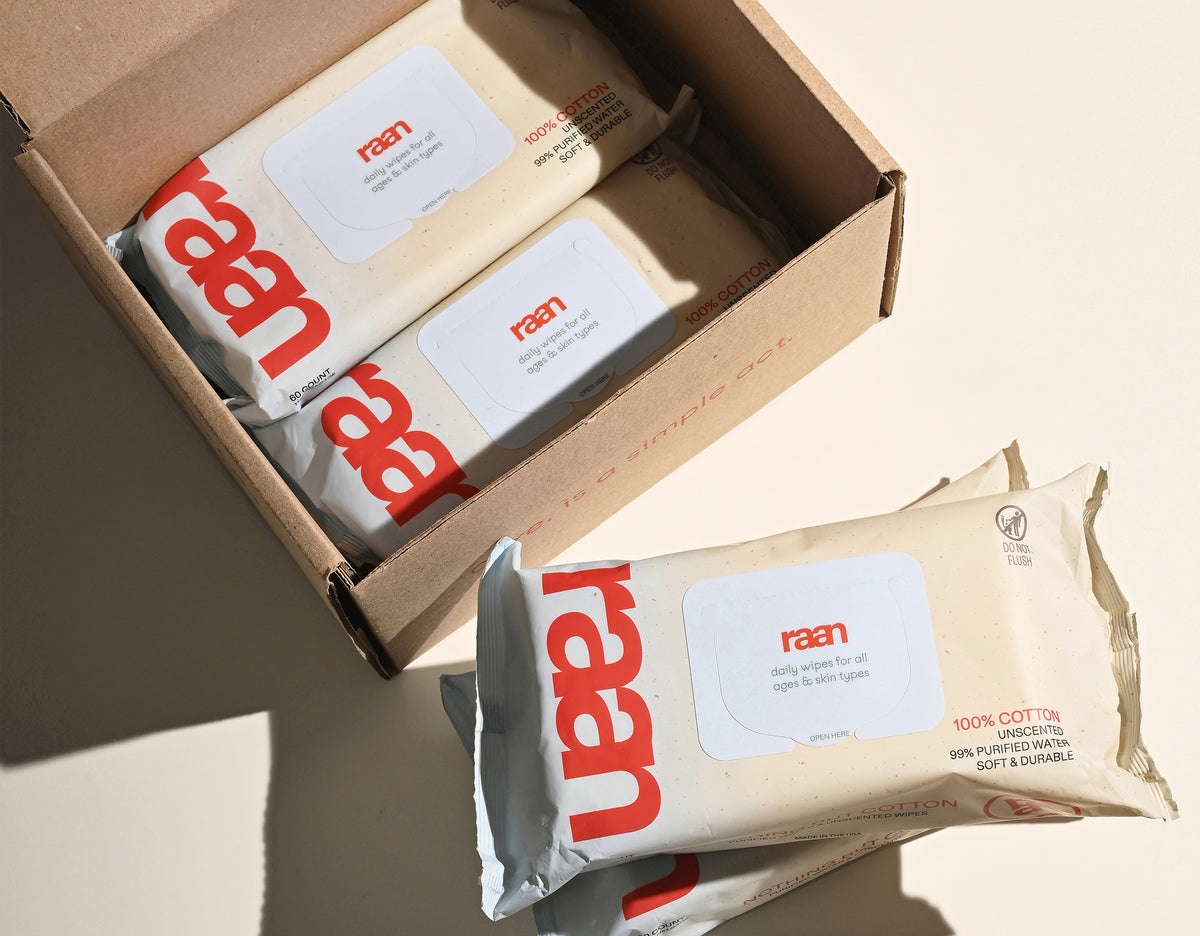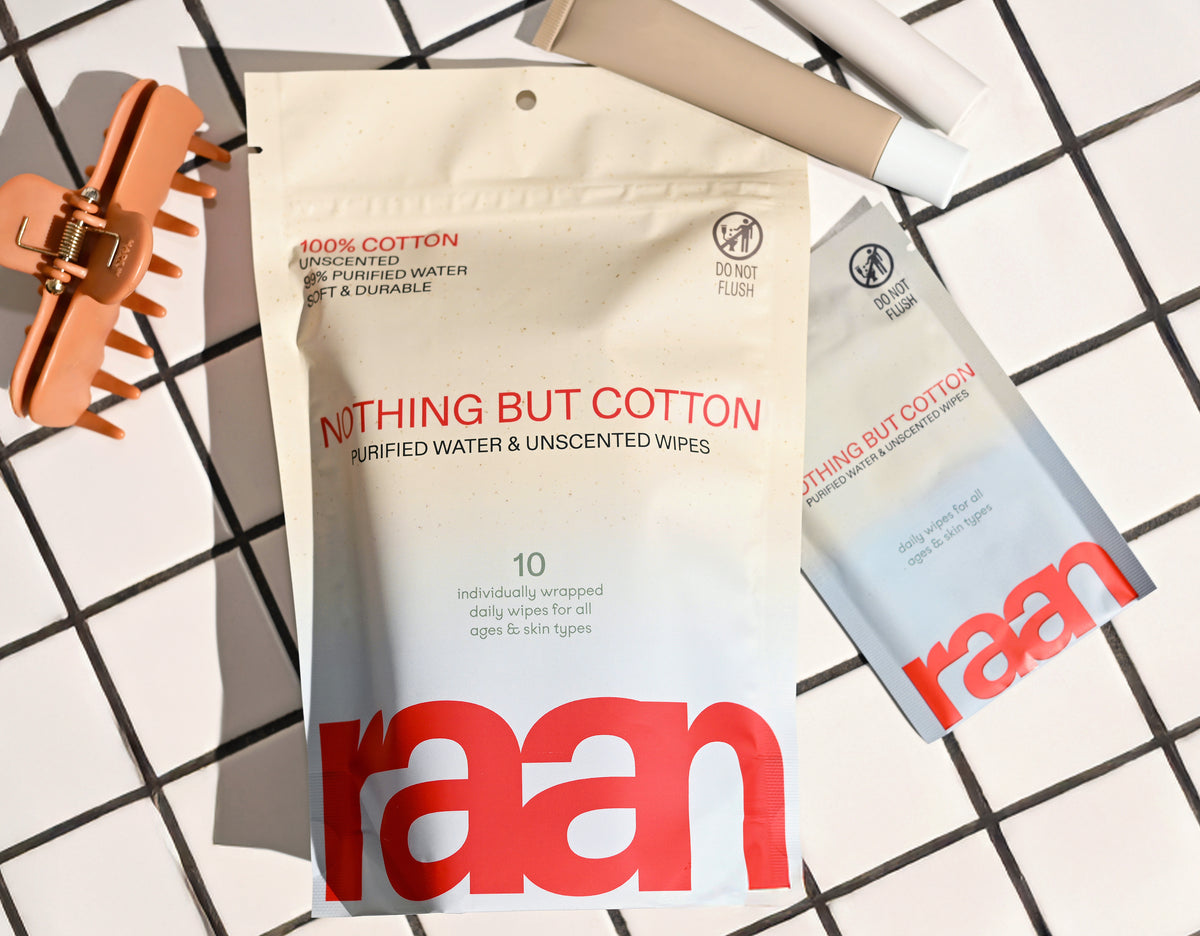Key Takeaways
- The best wet wipes focus on ingredient transparency and skin safety rather than marketing claims.
- Look for wipes made with unbleached cotton and food-grade preservatives for safer use.
- EWG verification is a reliable indicator of genuinely safe and clean ingredients.
- Raan cotton wipes contain 99% water, organic aloe, and only five carefully selected ingredients.
- Quality wipes avoid plastic fibers, synthetic fragrances, and unknown additives.
Table of Contents
- What Wet Wipes Are (and Aren't): Materials, Solutions & Real-World Uses
- Key Ingredients That Matter (and What to Watch Out For)
- Not All "Clean" Claims Are Created Equal, Decoding Label Jargon
- How to Choose the Best Wet Wipes for Your Needs
- Raan's Cotton Wipes: What Makes Our Simplicity Science-Backed
- The Science of Sensitive Skin: Choosing Wipes That Respect Your Barrier
- Wet Wipes for Everyday Life: Best Practices by Scenario
- Comparing Wet Wipe Types: Materials, Certifications & Environmental Impact
- Are "Flushable" Wipes Safe for Drains or the Planet?
- Sustainable Choices: Making Wet Wipes Less Wasteful, More Mindful
- Troubleshooting Common Wipe Concerns: Real Solutions for Real Life
What Wet Wipes Are (and Aren't): Materials, Solutions & Real-World Uses

A wet wipe consists of three components: the base material, the liquid solution, and the packaging. The base determines texture and biodegradability, unbleached cotton breaks down naturally, while synthetic blends and plastic fibers persist in landfills. The solution provides cleansing and preservation, ranging from simple water-based formulas to complex chemical cocktails.
Modern wet wipes serve diverse needs beyond traditional baby care. Sensitive skin wipes handle daily cleanups for all ages, face wipes offer quick refreshing, and body wipes tackle post-workout situations. The key difference lies in formulation intensity, gentler options like Raan prioritize skin barrier protection over aggressive cleaning power.
Packaging innovation matters more than most realize. Raan's approach eliminates hard plastic lids entirely, using 70% less plastic than standard wipes while incorporating 35% post-consumer recycled content. The result: functional, resealable pouches that reduce waste without sacrificing convenience.
Key Ingredients That Matter (and What to Watch Out For)
Reading wet wipe ingredients reveals the gap between marketing claims and actual formulations. Safe, effective wipes need surprisingly few components: purified water for cleansing, gentle preservatives for stability, and skin conditioners for comfort. Raan's five-ingredient formula exemplifies this approach, sodium benzoate and potassium sorbate (food-grade preservatives), ethylhexylglycerin (skin-conditioning), organic aloe (moisturizer), and citric acid (pH balance).
Red flags include synthetic fragrances (often listed simply as "fragrance"), parabens, ethanol, artificial dyes, and harsh surfactants. These additives serve cosmetic or cost-cutting purposes rather than skin health. "Fragrance-free" doesn't guarantee safety, check for essential oils or botanical extracts that can trigger sensitivities.
| Safe Ingredients | Purpose | Avoid | Why Skip |
|---|---|---|---|
| Purified Water | Primary cleanser | Alcohol/Ethanol | Drying, irritating |
| Food-grade preservatives | Prevent bacteria | Parabens | Hormone disruption concerns |
| Organic aloe | Soothe skin | Synthetic fragrance | Common allergen |
| Citric acid | pH balance | Artificial dyes | Unnecessary irritants |
Transparency means listing every ingredient with its specific purpose. When brands use terms like "cleansing complex" or "botanical blend," they're obscuring what you're actually putting on your skin.
Not All "Clean" Claims Are Created Equal, Decoding Label Jargon
Marketing terms like "natural," "eco-friendly," and "gentle" carry no regulatory meaning in personal care products. Real accountability comes through third-party certifications with specific criteria. EWG Verified requires ingredient safety screening against a database of 80,000+ chemicals. Natural Cotton certification ensures fiber purity without bleaching or synthetic processing.
Biodegradable claims vary wildly in meaning. Some products break down in commercial composting facilities within months, while others require specific conditions that don't exist in home compost or landfills. Raan's unbleached cotton naturally biodegrades without leaving microplastic residue, unlike synthetic fiber alternatives.
Packaging transparency matters equally. "Eco-friendly" packaging might contain recycled content but still use excessive plastic. Raan's 70% plastic reduction comes from eliminating hard lids while maintaining functionality, a tangible improvement over cosmetic changes like green coloring on conventional packages.
How to Choose the Best Wet Wipes for Your Needs

Start by identifying your primary use case, newborn care demands the gentlest formulations, while post-workout cleaning can handle slightly more robust ingredients. Sensitive skin users should prioritize unbleached materials and food-grade preservatives over synthetic alternatives that promise enhanced cleaning power.
Evaluate ingredient transparency before marketing claims. Brands listing specific preservatives and their purposes demonstrate confidence in their formulation. Vague terms like "cleansing agents" or "natural extracts" often hide problematic additives. EWG Verified products undergo ingredient screening against safety databases, providing third-party validation beyond brand promises.
Quick Decision Framework: Check the base material first (cotton vs. synthetic), then preservative type (food-grade vs. chemical), finally packaging waste (plastic content and recyclability). This order prioritizes skin safety, then environmental impact.
Consider packaging practicality for your lifestyle. Frequent travelers benefit from secure, leak-proof pouches, while home users can prioritize recyclable materials over portability. Raan's lid-free design reduces plastic waste while maintaining moisture retention, proving functionality and sustainability can coexist.
Raan's Cotton Wipes: What Makes Our Simplicity Science-Backed
Raan cotton wipes represent a fundamental rethinking of wet wipe formulation, not a stripped-down version of conventional products, but a ground-up approach prioritizing skin safety and environmental responsibility. Our unbleached, 100% cotton base eliminates plastic fibers entirely, while our five-ingredient solution focuses exclusively on essential functions: cleansing, preservation, and skin conditioning.
Our certifications reflect measurable standards rather than marketing positioning. EWG Verified status requires ingredient screening against 80,000+ chemicals for safety concerns. Natural Cotton certification ensures fiber purity without bleaching processes that can leave chemical residues. Made in USA designation supports supply chain transparency and quality control standards.
| Feature | Raan Cotton Wipes | Conventional Wipes |
|---|---|---|
| Base Material | Unbleached 100% cotton | Synthetic blends, plastic fibers |
| Preservatives | Food-grade only | Synthetic chemicals, parabens |
| Ingredient Count | 5 total ingredients | 15-30+ additives |
| Packaging Plastic | 70% reduction, no hard lid | Standard plastic containers |
| Certifications | EWG Verified, Natural Cotton | Often none or vague claims |
Our packaging innovation delivers 70% less plastic through intelligent design rather than compromise. Eliminating hard plastic lids while incorporating 35% post-consumer recycled content proves that environmental responsibility enhances rather than limits functionality. The result: best wet wipes that perform reliably while supporting both skin health and sustainable practices.
The Science of Sensitive Skin: Choosing Wipes That Respect Your Barrier
Sensitive skin requires extra protection due to compromised barrier function, the outer layer that prevents irritants from penetrating and moisture from escaping. Harsh preservatives, synthetic fragrances, and rough materials can trigger inflammatory responses that manifest as redness, itching, or rashes. Gentle formulations support barrier repair rather than further disruption.
Patch testing new wipes prevents adverse reactions before full use. Apply a small amount to the inner forearm, wait 24-48 hours, and observe for redness or irritation. This simple step identifies potential allergens before they affect larger or more sensitive areas like the face or diaper region.
Common triggers include synthetic fragrances (even in "unscented" products), alcohol-based preservatives, and residual bleaching chemicals in conventional materials. Unbleached cotton eliminates processing chemical exposure, while food-grade preservatives like those in Raan wipes minimize sensitivity risks without compromising product stability.
For more information on choosing the right wipes for delicate skin, see best wipes for delicate skin care.
Wet Wipes for Everyday Life: Best Practices by Scenario

Diaper changes require gentle but thorough cleaning. Use single-pass motions rather than repeated wiping, which can irritate sensitive skin. Allow skin to air dry briefly before applying fresh diapers to prevent moisture-related rashes.
Post-workout cleanup benefits from body-safe formulations that remove sweat and bacteria without disrupting skin pH. Face-safe options like Raan work effectively on hands and body, eliminating the need for multiple product types.
Travel and on-the-go use demands secure packaging that prevents drying and contamination. Reseal packages immediately after use and store in cool, dry locations. Raan's pouch design maintains moisture without bulky hard containers that crack or leak in bags.
Pet care applications require human-safe formulations, as pets often lick cleaned areas. Avoid products containing essential oils or harsh chemicals that can be toxic when ingested. Simple, food-grade formulations provide safety for both pet and owner.
For a deeper dive into the different types of wipes and their uses, check out best wipes.
Comparing Wet Wipe Types: Materials, Certifications & Environmental Impact
| Wipe Type | Base Material | Typical Preservatives | Environmental Timeline | Best Use Case |
|---|---|---|---|---|
| Cotton-Based | Unbleached cotton fibers | Food-grade compounds | Biodegrades in 2-5 weeks | Sensitive skin, newborns |
| Viscose Blend | Wood pulp + synthetic | Mixed preservative systems | Partial breakdown, 6-12 months | General household cleaning |
| Synthetic Plastic | Polyester, polypropylene | Chemical preservatives | Does not biodegrade | Industrial, heavy-duty cleaning |
| Bamboo Fiber | Processed bamboo pulp | Natural + synthetic mix | Biodegrades in 3-6 weeks | Eco-conscious users |
Material composition directly impacts both skin compatibility and environmental breakdown. Pure cotton fibers like those in Raan wipes maintain structural integrity during use while decomposing completely in appropriate conditions. Synthetic blends may feel similar initially but leave plastic microfibers that persist in soil and water systems.
EWG Verified certification requires ingredient-by-ingredient safety screening, distinguishing verified products from those making unsubstantiated "clean" claims. Natural Cotton certification ensures fiber purity without chemical bleaching processes that can leave residual irritants.
For more on the science and history of wet wipes, see wet wipe.
Are "Flushable" Wipes Safe for Drains or the Planet?
Municipal water treatment facilities report that "flushable" wipes cause 93% of equipment clogs, despite industry testing claims. These tests use laboratory conditions that don't replicate real plumbing systems with bends, joints, and varying water pressure. The result: billions in infrastructure damage annually.
Even biodegradable wipes require 3-6 weeks for complete breakdown under optimal composting conditions, far longer than the minutes between flushing and reaching treatment facilities. Wipes that claim rapid dissolution often contain chemicals that accelerate breakdown but may harm aquatic ecosystems.
Raan maintains complete transparency on disposal: trash only, never flush. This honest approach prevents costly plumbing repairs and environmental contamination. The most sustainable choice remains proper disposal combined with reduced packaging waste through our 70% plastic reduction design.
Reality Check: No wet wipe, regardless of marketing claims, should be flushed. Even accidentally flushed wipes can cause immediate blockages in older plumbing systems.
For further reading on biodegradable wipes and their environmental impact, visit biodegradable wipes.
To learn about recent advances in antimicrobial cleaning wipes, see this USDA research.
Sustainable Choices: Making Wet Wipes Less Wasteful, More Mindful
Production sustainability extends beyond final packaging to raw material sourcing and manufacturing processes. Unbleached cotton eliminates chlorine-based processing that creates toxic byproducts, while domestic manufacturing reduces transportation emissions compared to overseas production.
Packaging innovation creates the most immediate impact for conscious consumers. Raan's elimination of hard plastic lids removes 70% of packaging plastic while maintaining product integrity. The 35% post-consumer recycled content in our pouches diverts waste from landfills into functional reuse.
Consumption mindfulness matters more than perfect product choices. Using appropriate quantities, one wipe per cleaning task, reduces waste regardless of brand selection. Proper storage prevents premature drying that leads to product waste and repeat purchases.
End-of-life disposal requires realistic expectations about biodegradability claims. Home composting rarely achieves the temperatures and conditions necessary for rapid breakdown. Responsible landfill disposal, combined with reduced packaging waste, creates the most achievable environmental benefit for most users.
If you're looking to get started with a more sustainable routine, consider the starter set for a convenient introduction to better wet wipes.
Troubleshooting Common Wipe Concerns: Real Solutions for Real Life
Wipes drying out: Store packages in cool, dry locations away from direct sunlight. Press packaging seals firmly after each use. For partially dried wipes, add 1-2 drops of distilled water to restore moisture without diluting preservatives.
Package seal failure: Transfer remaining wipes to airtight containers immediately. Ziploc bags work temporarily, but rigid, reusable containers are best for longer-term storage. Always check for moisture retention and use wipes within the recommended period after opening.
Frequently Asked Questions
What ingredients should I look for in wet wipes to ensure they are safe and gentle on sensitive skin?
Look for wet wipes made with mostly purified water, gentle skin conditioners like organic aloe, and food-grade preservatives such as sodium benzoate and potassium sorbate. Avoid synthetic fragrances, bleach, and plastic fibers to reduce irritation and support sensitive skin.
How do unbleached cotton and food-grade preservatives contribute to the quality and safety of wet wipes?
Unbleached cotton provides a natural, plastic-free base that’s soft and biodegradable, avoiding harsh chemical treatments. Food-grade preservatives keep the wipes stable and safe without relying on synthetic or questionable chemicals, ensuring a cleaner, more transparent formula.
Why is EWG verification important when selecting wet wipes, and how does it affect ingredient transparency?
EWG verification means the ingredients meet strict safety standards based on scientific assessment, not marketing hype. It ensures full ingredient disclosure and helps you trust that the wipes are genuinely safe and free from harmful additives.
Are 'flushable' wet wipes truly safe for plumbing and the environment, and what should consumers consider regarding their environmental impact?
Most 'flushable' wipes don’t break down easily and can cause plumbing blockages and environmental harm. It’s better to choose wipes made from natural fibers like unbleached cotton and avoid flushing them, opting instead for responsible disposal to reduce plastic pollution and waste.






